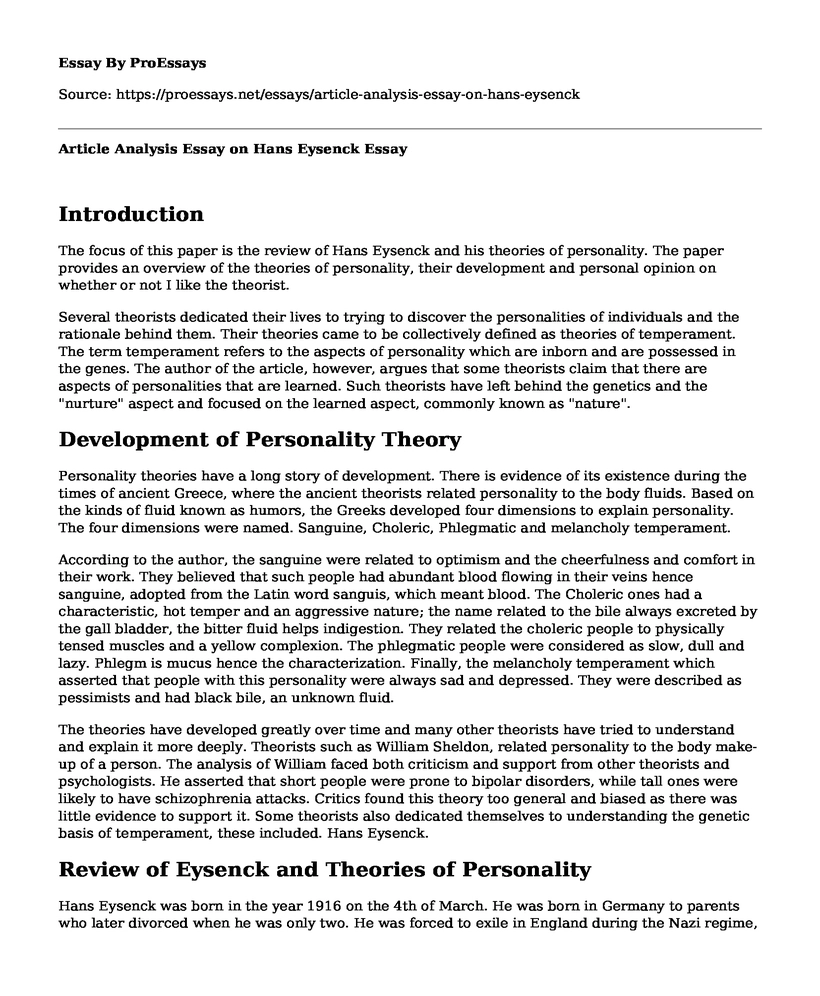Introduction
The focus of this paper is the review of Hans Eysenck and his theories of personality. The paper provides an overview of the theories of personality, their development and personal opinion on whether or not I like the theorist.
Several theorists dedicated their lives to trying to discover the personalities of individuals and the rationale behind them. Their theories came to be collectively defined as theories of temperament. The term temperament refers to the aspects of personality which are inborn and are possessed in the genes. The author of the article, however, argues that some theorists claim that there are aspects of personalities that are learned. Such theorists have left behind the genetics and the "nurture" aspect and focused on the learned aspect, commonly known as "nature".
Development of Personality Theory
Personality theories have a long story of development. There is evidence of its existence during the times of ancient Greece, where the ancient theorists related personality to the body fluids. Based on the kinds of fluid known as humors, the Greeks developed four dimensions to explain personality. The four dimensions were named. Sanguine, Choleric, Phlegmatic and melancholy temperament.
According to the author, the sanguine were related to optimism and the cheerfulness and comfort in their work. They believed that such people had abundant blood flowing in their veins hence sanguine, adopted from the Latin word sanguis, which meant blood. The Choleric ones had a characteristic, hot temper and an aggressive nature; the name related to the bile always excreted by the gall bladder, the bitter fluid helps indigestion. They related the choleric people to physically tensed muscles and a yellow complexion. The phlegmatic people were considered as slow, dull and lazy. Phlegm is mucus hence the characterization. Finally, the melancholy temperament which asserted that people with this personality were always sad and depressed. They were described as pessimists and had black bile, an unknown fluid.
The theories have developed greatly over time and many other theorists have tried to understand and explain it more deeply. Theorists such as William Sheldon, related personality to the body make-up of a person. The analysis of William faced both criticism and support from other theorists and psychologists. He asserted that short people were prone to bipolar disorders, while tall ones were likely to have schizophrenia attacks. Critics found this theory too general and biased as there was little evidence to support it. Some theorists also dedicated themselves to understanding the genetic basis of temperament, these included. Hans Eysenck.
Review of Eysenck and Theories of Personality
Hans Eysenck was born in the year 1916 on the 4th of March. He was born in Germany to parents who later divorced when he was only two. He was forced to exile in England during the Nazi regime, and this is where he specialized in the studies of psychology. He served in hospitals, lectured in universities and wrote many books and articles during his lifetime. He focused mainly on the theory of personality and genetic factors. According to the article, the relationship between psychology and genetics was useful in understanding the personalities of a person His research was based on statistical techniques, which helped him distinguish dimensions that were relevant in understanding people. After conducting researches on people he concluded that there were two major dimensions of personality. The extraversion-introversion temperament and the neuroticism temperament.
Neuroticism according to the theorist, referred to relatively calm people that were not too nervous and could express themselves. He described people who were frequently nervous as, ones suffering from nervous disorders and needed clinical interventions. He, however, claimed that it was not necessary for the clinical interventions to be used, since the nervous people, were normal and not extremely neurotic. The genetic basis of this disorder could be explained by examining the sympathetic nervous system, which as either over-responsive or normal. Extroversion-introversion temperament according to Hans was a result of the interaction of two dimensions regarding psychological problems. Introverts for examples exhibited, obsessive-compulsive disorders and phobia interacting.
Critique of the Article. Why I Like the Theorist.
I like the theorist because of the comprehensive methods that he used in the process of understanding the nature of psychology and the attempts to relate it to scientifically proven concepts. For example, the relationship between Neuroticism and the sensitivity of the sympathetic nervous system is rational. The sympathetic nervous system is autonomic and functions independently from the central nervous system and largely controls the emotion and responses to situations and stimuli in the environment. The theorist provides detailed examples of the possible symptoms of neuroticism, such as a panic attack. Making it reasonable enough to believe. Finally, the use of the statistical technique to sample the dimensions makes the entire process scientific .the results that he obtains are likely free from biases and judgments that are not accurate. He discovered Physcotisim, by sampling mental patients in several hospitals in England.
Reference
Boeree, G. (1998). Hans eysenck (1916-1997)(and other temperament theorists). Retrieved April 9, 2008.
Cite this page
Article Analysis Essay on Hans Eysenck. (2023, Apr 06). Retrieved from https://proessays.net/essays/article-analysis-essay-on-hans-eysenck
If you are the original author of this essay and no longer wish to have it published on the ProEssays website, please click below to request its removal:
- The Environmental Effects of Oil and Natural Gas Extraction Through Hydraulic Fracturing
- Paper Example on Oil and Gas Company: Risk Assessment and Management Plan
- Airport Operations and Management Challenges Paper Example
- The Unmanned Aerial System Essay Example
- 5 Deadliest Jets Fighter Aircrafts in the World Essay
- Summary for Engineering Economics Paper Example
- Essay Example on Christina Perri's Arms - A Hit Single From Love Strong Debut Album







